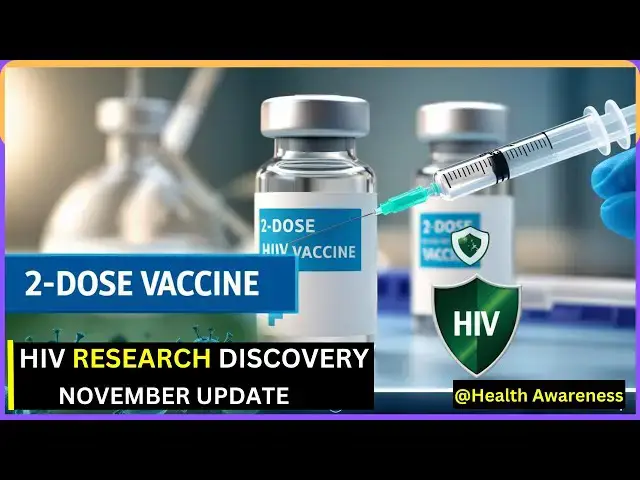0:00
developing an effective HIV vaccine has
0:02
been challenging for decades due to hi's
0:05
Rapid mutation rate allowing it to evade
0:09
responses however recent findings from
0:11
MIT researchers suggest a new approach
0:14
could finally make HIV vaccines
0:16
practical and more potent potentially
0:18
transforming the landscape of HIV
0:21
prevention this new study reveals that a
0:23
simplified twood dose vaccine schedule
0:25
can elicit a strong lasting immune
0:27
response offering a major breakthrough
0:29
in the quest for an HIV
0:31
vaccine the problem with traditional
0:35
approaches one reason HIV has been
0:38
difficult to combat with vaccines is the
0:40
virus's unique ability to mutate
0:42
rapidly unlike viruses such as measles
0:45
or polio which remain relatively stable
0:48
and easy to Target with a single vaccine
0:50
hiv's genetic makeup can quickly change
0:53
making it challenging to mount a
0:54
sustained immune response traditional
0:57
vaccines often rely on multiple doses
1:00
spaced out over time to build up the
1:02
body's defenses but this approach isn't
1:04
practical for HIV due to the virus's
1:08
tactics a previous MIT study showed that
1:11
a series of escalating doses of HIV
1:13
vaccines over 2 weeks could increase
1:15
neutralizing antibodies yet this
1:17
protocol was complex and challenging for
1:20
large-scale vaccination
1:22
campaigns the new twod do vaccine
1:26
works in a recent study MIT researchers
1:30
have developed a simplified approach a
1:31
two-d do vaccine given over a short
1:33
interval just one week apart the first
1:36
dose a much smaller priming shot
1:39
prepares the immune system to recognize
1:41
and respond to the virus setting up a
1:43
foundation for the second dose this
1:45
priming dose helps a small number of
1:47
immune cells specifically B cells to
1:49
start producing antibodies against
1:52
HIV when the second larger dose is
1:55
administered a week later it builds upon
1:57
this immune memory leading to a robust
2:01
response the scientists behind this
2:03
breakthrough combined computational
2:05
models with experimental studies in mice
2:07
using an HIV envelope protein as the
2:09
main vaccine component this protein
2:12
structure is designed to closely
2:13
resemble HIV structure allowing the
2:16
immune system to recognize and react to
2:18
it a single dose version of this vaccine
2:21
is currently in clinical trials but the
2:23
researchers are optimistic that the two-
2:25
do approach could be even more effective
2:28
potentially becoming a model for H I
2:30
vaccines in the future mechanism of the
2:34
approach in this study the researchers
2:37
tested different dosing regimens
2:39
comparing 1 two and up to seven doses
2:41
given over 12 days initially the team
2:44
found that while three or more doses
2:46
generated strong antibody responses just
2:48
two doses didn't yield the same
2:51
results however by adjusting the timing
2:53
and ratio of doses they discovered that
2:55
a regimen of 20% of the vaccine given in
2:57
the first dose followed by 80% a week
3:00
later produced a similar immune response
3:03
schedule this discovery marked a major
3:06
step forward as it demonstrated that a
3:08
much simpler twood dose regimen could
3:10
produce strong antibody levels without
3:12
the logistical difficulties of multiple
3:14
doses why two doses work better than one
3:18
the researchers used computational
3:20
models to explore why the two- dose
3:23
effectively when a single large dose of
3:26
the vaccine is administered most of the
3:28
HIV protein anti in the part of the
3:30
virus that triggers an immune response
3:32
is quickly broken down in the body which
3:34
reduces its Effectiveness before it
3:36
reaches lymph nodes in lymph nodes
3:39
immune cells known as B cells are
3:41
activated to Target a specific virus or
3:45
antigen however by using a smaller
3:47
initial dose researchers found that some
3:49
B cells did begin to produce antibodies
3:51
without depleting too much of the
3:53
antigen when the larger second dose
3:56
followed these antibodies helped guide
3:58
the HIV protein directly to the lymph
4:00
nodes where more B cells encountered it
4:02
and ramped up antibody production
4:04
producing a powerful immune
4:06
response the two- Doos schedule also
4:09
triggered a five-fold Improvement in te-
4:10
cell response and a 60-fold increase in
4:13
antibody levels compared to a single
4:14
dose vaccine te- cells another essential
4:17
component of the immune system help
4:19
coordinate immune responses and may
4:21
provide additional layers of
4:23
protection implications Beyond HIV
4:26
potential for other vaccines
4:29
this two- Doos strategy isn't only
4:31
promising for HIV according to lead
4:34
author Dr erup chakra this new
4:36
understanding could also benefit vaccine
4:38
development for other rapidly mutating
4:42
pathogens the approach combines
4:44
principles from Immunology biology and
4:46
computational modeling to understand how
4:48
the immune system can be primed in a way
4:50
that's both efficient and effective
4:53
Dr darl Irvine now at the scripts
4:56
Research Institute adds that many
4:58
Technologies are being developed that
5:00
could potentially deliver this twood do
5:02
sequence in a single shot making it even
5:04
more practical for Mass
5:06
vaccinations next steps in the
5:09
research the researchers are planning to
5:11
test this two-d do approach in non-human
5:14
primates a key step before progressing
5:17
trials they're also exploring the use of
5:20
Advanced Materials to develop a vaccine
5:22
that could release the second dose over
5:23
time which would allow for even greater
5:27
Effectiveness additionally the team aims
5:30
to refine their dosing schedules and
5:32
strategies as well as to explore the
5:34
potential of this approach in other
5:37
HIV by better understanding how the
5:39
immune system can be primed for a rapid
5:41
and strong response they hope to develop
5:44
vaccines that can offer similar benefits
5:47
infections a glimpse into the future of
5:52
prevention with HIV continuing to infect
5:55
over a million people globally every
5:57
year especially in regions with limited
5:59
access to antiviral medications the
6:02
promise of an effective vaccine has
6:05
pressing this two-d do vaccine model
6:07
could not only simplify vaccination
6:09
efforts but could also reduce the number
6:11
of doses required for Effective immunity
6:14
making it a GameChanger for HIV
6:16
prevention if the ongoing trials and
6:19
future research confirm its
6:20
Effectiveness this vaccine could become
6:22
a leading tool in the fight against HIV
6:25
with potential applications for other
6:27
diseases that similarly evade immune
6:31
the simplified two-d do vaccine approach
6:33
represents an Innovative step toward
6:35
practical scalable HIV vaccination
6:38
efforts through a combination of
6:40
Immunology insights computational
6:42
modeling and experimental studies MIT
6:45
researchers have developed a promising
6:47
vaccine strategy that could offer hope
6:49
in the ongoing battle against
6:51
HIV this approach also hints at broader
6:54
possibilities for Designing vaccines
6:56
that are both effective and feasible for
7:00
by making it easier to mount an
7:01
effective immune response this strategy
7:04
could pave the way for new breakthroughs
7:05
in the prevention of not only HIV but
7:08
potentially other challenging viruses in
7:11
future thanks for watching for more
7:14
interesting Health video don't forget to
7:15
subscribe like and share this video and
7:18
see you in our next video


